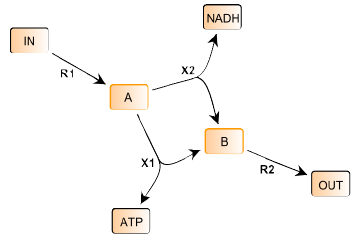Flux Balance Constraint (analysis)
- Analysis title
 Flux Balance Constraint
Flux Balance Constraint
- Provider
- Institute of Systems Biology
- Class
FbcAnalysis- Plugin
- biouml.plugins.fbc (Flux Balance)
Flux Balance Analysis
Flux balance analysis is a mathematical approach for analyzing the flow of metabolites through a metabolic network.
Metabolic reactions are represented as a stoichiometric matrix S. The flux through all of the reactions in a network is represented by the vector v. Flux Balance Analysis seeks to maximize or minimize an objective function Z = cTv, which can be any linear combination of fluxes, where c is a vector of weights, indicating how much each reaction contributes to the objective function. FBA can thus be defined as the use of linear programming to solve the equation Sv = 0 given a set of upper and lower bounds on v and a linear combination of fluxes as an objective function.
Parameters:
- Diagram – Path to input diagram
- Data table – Path to the table with initial FBC data (bounds, objective function coefficients)
- Output path – Path to table with fluxes values
- Optimization type (expert) – Type of objective function optimization which will be used (maximize or minimize)
- Solver type (expert) – Type of the solver which will be used to find fluxes
- Max iter (expert) – Maximal iteration number
One should use Building Flux Balance DataTable or Score based FBC table builder analyses to generate FBC data table.
Example
FBC syntax example: a simple four reaction pathway. The reactions are R1, R2, X1, X2 with fixed species IN, OUT, ATP, NADH and variable species A, B.
Using the reagent identity and stoichiometry it is possible to compactly describe this network in terms of its reaction stoichiometry:
There are capacity constraints in this example:
In this example the flux through reaction R2 will be maximized. Solving this we find that maximization of flux through R2 gives an optimal solution R2 = 1 with one possible solution for v.
- Jeffrey D. Orth, Ines Thiele and Bernhard O. Palsson, "What is flux balance analysis?". Nature Biotechnology 28, 245-248 2010.
- SBML Level 3 Package Specification



